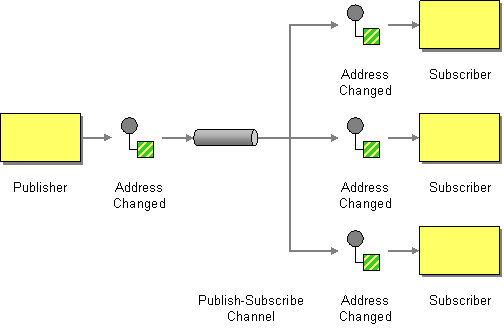Fuse 6 is no longer supported
As of February 2025, Red Hat Fuse 6 is no longer supported. If you are using Fuse 6, please upgrade to Red Hat build of Apache Camel.이 콘텐츠는 선택한 언어로 제공되지 않습니다.
5.2. Publish-Subscribe Channel
Overview
링크 복사링크가 클립보드에 복사되었습니다!
A publish-subscribe channel, shown in Figure 5.2, “Publish Subscribe Channel Pattern”, is a message channel that enables multiple subscribers to consume any given message. This is in contrast with a point-to-point channel. Publish-subscribe channels are frequently used as a means of broadcasting events or notifications to multiple subscribers.
Figure 5.2. Publish Subscribe Channel Pattern
Components that support publish-subscribe channel
링크 복사링크가 클립보드에 복사되었습니다!
The following Apache Camel components support the publish-subscribe channel pattern:
JMS
링크 복사링크가 클립보드에 복사되었습니다!
In JMS, a publish-subscribe channel is represented by a topic. For example, you can specify the endpoint URI for a JMS topic called
StockQuotes as follows:
jms:topic:StockQuotes
jms:topic:StockQuotes
See chapter "JMS" in "EIP Component Reference" for more details.
ActiveMQ
링크 복사링크가 클립보드에 복사되었습니다!
In ActiveMQ, a publish-subscribe channel is represented by a topic. For example, you can specify the endpoint URI for an ActiveMQ topic called
StockQuotes, as follows:
activemq:topic:StockQuotes
activemq:topic:StockQuotes
See chapter "ActiveMQ" in "EIP Component Reference" for more details.
XMPP
링크 복사링크가 클립보드에 복사되었습니다!
The XMPP (Jabber) component supports the publish-subscribe channel pattern when it is used in the group communication mode. See chapter "XMPP" in "EIP Component Reference" for more details.
Static subscription lists
링크 복사링크가 클립보드에 복사되었습니다!
If you prefer, you can also implement publish-subscribe logic within the Apache Camel application itself. A simple approach is to define a static subscription list, where the target endpoints are all explicitly listed at the end of the route. However, this approach is not as flexible as a JMS or ActiveMQ topic.
Java DSL example
링크 복사링크가 클립보드에 복사되었습니다!
The following Java DSL example shows how to simulate a publish-subscribe channel with a single publisher,
seda:a, and three subscribers, seda:b, seda:c, and seda:d:
from("seda:a").to("seda:b", "seda:c", "seda:d");
from("seda:a").to("seda:b", "seda:c", "seda:d");Note
This only works for the InOnly message exchange pattern.
XML configuration example
링크 복사링크가 클립보드에 복사되었습니다!
The following example shows how to configure the same route in XML:
